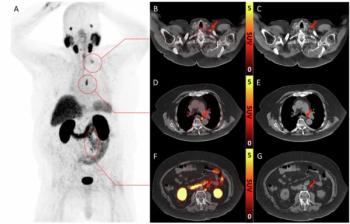
Dextrose lessens RFA complications
An intraperitoneal injection of dextrose prior to radiofrequency ablation of peripheral liver tumors reduces postprocedural pain and the need for painkillers, according to two studies in the May issue of the American Journal of Roentgenology. The technique could make treatment available to a larger pool of patients by rendering RFA safer in anatomically challenging areas.
An intraperitoneal injection of dextrose prior to radiofrequency ablation of peripheral liver tumors reduces postprocedural pain and the need for painkillers, according to two studies in the May issue of the American Journal of Roentgenology. The technique could make treatment available to a larger pool of patients by rendering RFA safer in anatomically challenging areas.
Peripheral liver tumors close to the diaphragm or the body wall usually result in severe, long-lasting pain after percutaneous RFA treatment. Physicians may also avoid ablation altogether if they deem tumors too close to the bowel. Techniques to insulate tumors have used saline, sterile water, gas, and balloon dilators.
Although saline has shown relative success, the ionic solution may increase the risk of thermal injury. In contrast, a solution of 5% dextrose in water (D5W) is well tolerated in virtually every body space. It is near isotonic, allowing for rapid absorption, and nonionic, which translates into minimal interaction with electrical current.
Principal investigator Dr. J. Louis Hinshaw and colleagues at the University of Wisconsin at Madison's radiology department retrospectively reviewed results from 20 consecutive patients who underwent RFA of peripheral liver tumors, 10 of whom received an intraperitoneal D5W infusion before ablation. They compared the two groups for ablation zone size, degree of liver capsule involvement, number of burns, patient-reported pain, patient-controlled analgesia use, and hospital stay length.
Investigators found treatment with intraperitoneal D5W before RFA reduced pain, narcotic use, and length of hospital stay. They also found pretreatment with D5W most effective during the first 16 hours after the procedure.
Patients in the D5W group reported significantly less pain in the first 24 hours after the procedure than did the controls despite a statistically significant decrease in patient-controlled analgesia (p = 0.003). Total volume of ablation, liver surface involvement, and number of burns were slightly higher in the D5W group, but the difference was not statistically significant.
In a different study, another group of UW-Madison researchers from the radiology and the biostatistics and medical informatics departments compared the effectiveness of saline and D5W to protect the diaphragm and lungs during open surgery liver RFA of 10 domestic swine. They found instillation of D5W into the peritoneal cavity before liver RFA reduced the risk and severity of diaphragm and lung injuries.
Results from both studies validate previous findings proposing dextrose as a valid technique for liver isolation to avoid inadvertent thermal injury to adjacent structures during RFA. Pretreatment with D5W may increase both the safety and the number of patients eligible for treatment with thermal therapies, investigators wrote in the study.
"Techniques such as this promise to increase the safety and expand the scope of percutaneous radiofrequency ablation while further decreasing the associated complications and cost," they said.
For more information, visit Diagnostic Imaging's
Newsletter
Stay at the forefront of radiology with the Diagnostic Imaging newsletter, delivering the latest news, clinical insights, and imaging advancements for today’s radiologists.






























